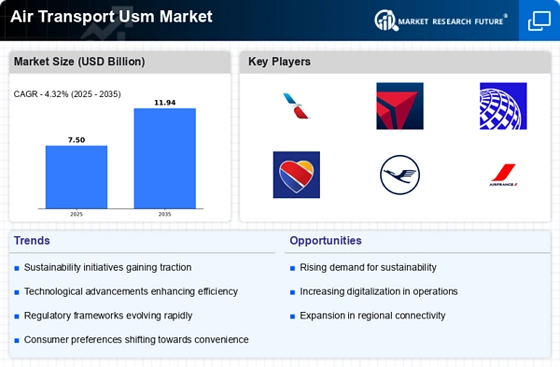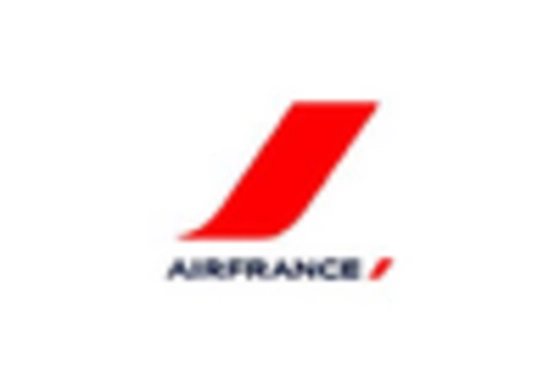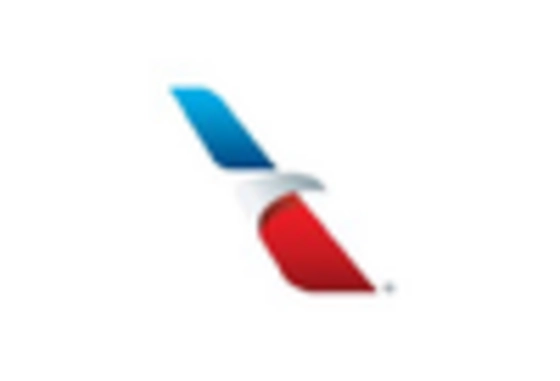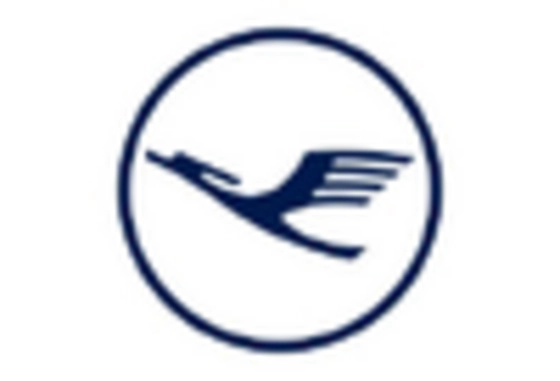Shifts in Consumer Travel Behavior
Shifts in consumer travel behavior are significantly influencing the Air Transport Usm Market Industry. As travelers increasingly prioritize convenience and flexibility, airlines are adapting their offerings to meet these evolving preferences. The rise of low-cost carriers and the introduction of dynamic pricing models are reshaping the competitive landscape. Data suggests that leisure travel is on the rise, with a growing number of consumers willing to spend on unique travel experiences. This trend indicates that airlines may need to innovate their service offerings to attract and retain customers. Moreover, the increasing importance of health and safety in travel decisions is likely to shape operational protocols within the Air Transport Usm Market Industry, as airlines strive to enhance passenger confidence.
Rising Demand for Air Cargo Services
The Air Transport Usm Market Industry is witnessing a notable increase in demand for air cargo services, driven by the growth of e-commerce and global trade. As businesses seek faster delivery options to meet consumer expectations, air freight is becoming an increasingly attractive solution. According to recent data, the air cargo sector is projected to grow at a compound annual growth rate of approximately 4.5% over the next five years. This trend suggests that logistics companies are likely to invest more in air transport capabilities, thereby enhancing the overall efficiency of the Air Transport Usm Market Industry. Additionally, the rise in cross-border e-commerce is expected to further bolster the demand for air cargo, as companies strive to reach international markets swiftly.
Increasing Investment in Airport Infrastructure
Investment in airport infrastructure is a critical driver for the Air Transport Usm Market Industry. Many countries are recognizing the need to modernize and expand their airport facilities to accommodate growing passenger and cargo traffic. Recent reports indicate that global airport infrastructure investment is expected to reach over 100 billion dollars annually in the coming years. This influx of capital is likely to enhance the capacity and efficiency of airports, thereby facilitating smoother operations for airlines. Improved airport facilities can lead to shorter turnaround times and better passenger experiences, which may ultimately contribute to the growth of the Air Transport Usm Market Industry. Additionally, enhanced connectivity through upgraded airports can stimulate regional economic development.
Regulatory Support for Air Transport Usm Market
The Air Transport Usm Market Industry is currently experiencing a favorable regulatory environment, which appears to be driving growth. Governments are increasingly recognizing the importance of air transport in economic development and are implementing policies that support the expansion of air services. For instance, various countries have streamlined their aviation regulations to facilitate easier entry for new airlines, thereby enhancing competition. This regulatory support is likely to lead to increased investment in infrastructure, which is essential for the growth of the Air Transport Usm Market Industry. Furthermore, international agreements aimed at reducing barriers to air travel may also contribute to a more robust market landscape, potentially resulting in a more interconnected global air transport network.
Technological Advancements in Air Transport Usm Market
Technological advancements are playing a pivotal role in shaping the Air Transport Usm Market Industry. Innovations such as advanced air traffic management systems, fuel-efficient aircraft, and automated baggage handling are enhancing operational efficiency and safety. The integration of artificial intelligence and big data analytics is also enabling airlines to optimize routes and reduce operational costs. As airlines adopt these technologies, they are likely to improve customer experience and streamline operations, which could lead to increased market share. Furthermore, the ongoing development of sustainable aviation technologies may attract environmentally conscious consumers, thereby expanding the customer base within the Air Transport Usm Market Industry.

















Leave a Comment